France was ruled by monarchs from the establishment of the Kingdom of West Francia in 843 until the end of the Second French Empire in 1870, with several interruptions.[1][2]

Classical French historiography usually regards Clovis I, king of the Franks (r. 509–511), as the first king of France. However, historians today consider that such a kingdom did not begin until the establishment of West Francia, during the dissolution of the Carolingian Empire in the 800s.[1][2]
頭銜
The kings used the title "King of the Franks" (拉丁語:Rex Francorum) until the late twelfth century; the first to adopt the title of "King of France" (Latin: Rex Franciae; French: roi de France) was Philip II in 1190 (r. 1180–1223), after which the title "King of the Franks" gradually lost ground.[3] However, Francorum Rex continued to be sometimes used, for example by Louis XII in 1499, by Francis I in 1515, and by Henry II in about 1550; it was also used on coins up to the eighteenth century.[4]
During the brief period when the French Constitution of 1791 was in effect (1791–1792) and after the July Revolution in 1830, the style "King of the French" (roi des Français) was used instead of "King of France (and Navarre)". It was a constitutional innovation known as popular monarchy which linked the monarch's title to the French people rather than to the possession of the territory of France.[5]
With the House of Bonaparte, the title "Emperor of the French" (Empereur des Français) was used in 19th-century France (during the first and second French Empires) between 1804 and 1814, again in 1815, and between 1852 and 1870.[6]
From the 14th century down to 1801, the English (and later British) monarch claimed the throne of France, though such claim was purely nominal excepting a short period during the Hundred Years' War when Henry VI of England had control over most of Northern France, including Paris. By 1453, the English had been mostly expelled from France and Henry's claim has since been considered illegitimate; French historiography commonly does not recognize Henry VI of England among the kings of France.
法蘭克國王
In August 843 AD, the Treaty of Verdun divided Francia into three kingdoms, one of which (Middle Francia) was short-lived; the other two evolved into France (West Francia) and, eventually, Germany (East Francia). By this time, the eastern and western parts of the land had already developed different languages and cultures.[7][8]
The Carolingians were a Frankish noble family with origins in the Arnulfing and Pippinid clans of the 7th century AD. The family consolidated its power in the 8th century, eventually making the offices of mayor of the palace and dux et princeps Francorum hereditary and becoming the real powers behind the Merovingian kings. The dynasty is named after one of these mayors of the palace, Charles Martel, whose son Pepin the Short dethroned the Merovingians in 751 and, with the consent of the Papacy and the aristocracy, was crowned King of the Franks.[9] Under Charles the Great (r. 768–814), better known as "Charlemagne", the Frankish kingdom expanded deep into Central Europe, conquering Italy and most of modern Germany. He was succeeded by his son Louis the Pious (r. 814–840), who eventually divided the kingdom between his sons. His death, however, was followed by a 3-year-long civil war that ended with the Treaty of Verdun. Modern France developed from West Francia, while East Francia became the Holy Roman Empire and later Germany.
| 肖像 | 姓名 | 統治時間 | 與前任君主的關聯 | 生平 |
|---|---|---|---|---|

|
查理二世 「禿頭」[a] |
約 843年8月10日[i]–877年10月6日 (34年2個月) |
虔誠者路易之子和查理曼之孫。在凡爾登條約後被認可為王 | 823年6月13日[b] – 6 October 877 (aged 54) King of Aquitaine since 838. Crowned "Emperor of the Romans" on Christmas 875. Died of natural causes[12] |

|
Louis II "the Stammerer"[c] |
6 October 877[ii] – 10 April 879 (1年6個月又4天) |
禿頭查理之子 | 1 November 846 – 10 April 879 (aged 32) King of Aquitaine since 867. Died of natural causes.[14] |

|
Louis III | 10 April 879[iii] – 5 August 882 (3年3個月又26天) |
Son of Louis the Stammerer | 863 – 5 August 882[d] (aged 19) Ruled the North; died after hitting his head with a lintel while riding his horse.[20] |

|
Carloman II | 10 April 879[iv] – 6 December 884 (5年7個月又26天) |
Son of Louis the Stammerer | 866 – 6 December 884[e] (aged 18) Ruled the South; died after being accidentally stabbed by his servant.[23] |

|
Charles (III) "the Fat"[f] |
6 December 884[v] – 11 November 887[g] (2年11個月又5天) |
Son of Louis II the German, king of East Francia, and grandson of Louis I | 839[h] – 13 January 888 (aged 48–49) King of East Francia since 876; crowned Emperor in 881. Last ruler to control all Frankish territories. Deposed by the nobility, later dying of natural causes[29] |
| Portrait | Name | Reign | Succession | Life details |
|---|---|---|---|---|

|
Odo / Eudes | 29 February 888[vi] – 3 January 898 (9年10個月又15天) |
Son of Robert the Strong; elected king following the deposition of Charles III. Initially rivaled by Guy III of Spoleto and Ranulf II of Aquitaine | 約 858 – 3 January 898[i] (aged approx. 40) Defended Paris from the Vikings; died of natural causes[33] |
| Portrait | Name | Reign | Succession | Life details |
|---|---|---|---|---|

|
Charles III "the Simple" |
3 January 898[vii] – 29 June 922 (24年5個月又26天) |
Posthumous son of Louis II the Stammerer; proclaimed king in opposition to Odo in January 893 | 17 September 879 – 7 October 929 (aged 50) Deposed by Robert's followers; later captured by Herbert II, Count of Vermandois. Died in captivity[34] |
| Portrait | Name | Reign | Succession | Life details |
|---|---|---|---|---|

|
Rodolph / Raoul | 15 June 923[ix]– 14 January 936 (12年6個月又30天) |
Son of Richard, Duke of Burgundy and son-in-law of Robert I | Duke of Burgundy since 921. Died of illness after a reign of constant civil war and viking raids. Lose Lotharingia (Lorraine) to Henry I of Germany[37] |
| Portrait | Name | Reign | Succession | Life details |
|---|---|---|---|---|
| File:Denier Chinon 954, obverse.jpg | Louis IV "from Overseas" |
19 June 936[x] – 10 September 954 (18年2個月又22天) |
Son of Charles the Simple, recalled to France after being exiled to England | 921 – 10 September 954 (aged 33) Died after falling off his horse[38] |

|
Lothair | 10 September 954[xi] – 2 March 986 (31年5個月又20天) |
Son of Louis IV | 941 – 2 March 986 (aged 44) Died of natural causes[39] |
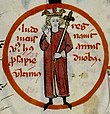
|
Louis V "the Do-Nothing" |
2 March 986[xii] – 22 May 987 (1年2個月又20天) |
Son of Lothair | 967 – 22 May 987[k] (aged 20) Died in a hunting accident[41] |
卡佩王朝( 987年—1792年)
The Capetian dynasty is named for Hugh Capet, a Robertian who served as Duke of the Franks and was elected King in 987. Except for the Bonaparte-led Empires, every monarch of France was a male-line descendant of Hugh Capet. The kingship passed through patrilineally from father to son until the 14th century, a period known as Direct Capetian rule. Afterwards, it passed to the House of Valois, a cadet branch that descended from Philip III. The Valois claim was disputed by Edward III, the Plantagenet king of England who claimed himself as the rightful king of France through his french mother; the two houses fought the Hundred Years' War over the issue, and with Henry VI of England being for a time partially recognized as King of France. The Valois line died out in the late 16th century, during the French Wars of Religion, to be replaced by the distantly related House of Bourbon, which descended through the Direct Capetian Louis IX. The Bourbons would rule France until deposed in the French Revolution, though they would be restored to the throne after the fall of Napoleon. The last Capetian to rule would be Louis Philippe I, king of the July Monarchy (1830–1848), a member of the cadet House of Bourbon-Orléans.
The House of Capet are also commonly known as the "Direct Capetians".
| Portrait | Name | Arms | Reign | Succession | Life details |
|---|---|---|---|---|---|

|
Hugh "Capet" Hugues Capet[l] |
1 June 987[xiii] – 24 October 996 (9年4個月又23天) |
Son of Hugh the Great and grandson of Robert I[m] | 約 940 – 24 October 996 (aged approx. 55) Duke of the Franks since 956. Died of natural causes.[45] | |

|
Robert II "the Pious" | 24 October 996[xiv] – 20 July 1031 (34年8個月又26天) |
Only son of Hugh Capet | 約 970 – 20 July 1031 (aged approx. 60) Married thrice, getting excommunicated by the Catholic Church. Incorporated the Duchy of Burgundy[46] | |
| Hughes (junior king)[n] |
19 June 1017 – 17 September 1025 (under Robert II) |
Son of Robert II | 約 1007 – 17 September 1025 (aged approx. 18)[47] | ||

|
Henry I Henri |
20 July 1031[xv] – 4 August 1060 (29年15天) |
Son of Robert II | 約 1005 – 4 August 1060 (aged approx. 55) His reign was marked with internal struggle against feudal lords[48] | |

|
Philip I "the Amorous" Philippe |
4 August 1060[xvi] – 29 July 1108 (47年11個月又25天) |
亨利一世之子 | 1052 – 29 July 1108 (aged 56) Ruled under the regency of Anne of Kiev and Count Baldwin V until 1066[49] | |

|
Louis VI "the Fat" | 29 July 1108[xvii] – 1 August 1137 (29年3天) |
腓力一世之子 | 1081 – 1 August 1137 (aged 56) His reign contributed to the centralization of royal power. First king to wage war against the English[50] | |
| Philippe (junior king)[n] |
14 April 1129 – 13 October 1131 (under Louis VI) |
路易六世之子 | 29 August 1116 – 13 October 1131 (aged 15)[51] | ||

|
Louis VII "the Young" | 1 August 1137[xviii] – 18 September 1180 (43年1個月又17天) |
路易六世之子 | 1120 – 18 September 1180 (aged 60) Known for his rivalry with Henry II of England and his military campaigns during the Second Crusade[52] | |

|
Philip II "Augustus" Philippe Auguste |

|
18 September 1180[xix]– 14 July 1223 (42年9個月又26天) |
路易七世之子 | 21 August 1165 – 14 July 1223 (aged 57) Regarded as one of the greatest French rulers. First monarch to style himself as "King of France"[53] |

|
Louis VIII "the Lion" | 14 July 1223[xx]– 8 November 1226 (3年3個月又25天) |
腓力二世之子 | 5 September 1187 – 8 November 1226 (aged 39) Proclaimed king of England in 1216, after which he led an unsuccessful invasion[54] | |

|
Louis IX "the Saint" | 8 November 1226[xxi]– 25 August 1270 (43年9個月又17天) |
路易八世之子 | 25 April 1214 – 25 August 1270 (aged 56) Ruled under the regency of Blanche of Castile until 1234. Died during the 8th Crusade; only king to be venerated by the Catholic Church[55] | |

|
Philip III "the Bold" Philippe |
25 August 1270[xxii]– 5 October 1285 (15年1個月又10天) |
路易九世之子 | 3 April 1245 – 5 October 1285 (aged 40) Greatly expanded French influence in Europe. Died of a fever[56] | |

|
Philip IV "the Fair" Philippe |

|
5 October 1285[xxiii] – 29 November 1314 (29年1個月又24天) |
腓力三世之子 | 1268 – 29 November 1314 (aged 46) King of Navarre (as Philip I) since 16 August 1284, following his marriage with Joan I. Remembered for his struggle with the Roman papacy and his consolidation of royal power, which to helped reduce the influence of feudal lords[57] |

|
Louis X "the Quarreller" |
29 November 1314[xxiv]– 5 June 1316 (1年6個月又7天) |
腓力四世之子 | 3 October 1289 – 5 June 1316 (aged 26) King of Navarre (as Louis I) since 2 April 1305. His short reign was marked by conflicts with the nobility[58] | |
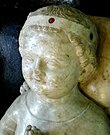
|
John I "the Posthumous" Jean |
15–20 November 1316 (5 days) |
路易十世之遺腹子 | King for the five days he lived; shortest undisputed monarch in French history[59][o] | |

|
Philip V "the Tall" Philippe |
20 November 1316[xxv]– 3 January 1322 (5年1個月又14天) |
腓力四世之子和約翰一世之叔 | 1294 – 3 January 1322 (aged 28) King of Navarre as Philip II. Died without a male heir[61] | |

|
Charles IV "the Fair" | 3 January 1322[xxvi]– 1 February 1328 (6年29天) |
腓力四世之子和肥力五世之弟 | 1294 – 1 February 1328 (aged 34) King of Navarre as Charles I. Died without a male heir, ending the direct line of Capetians[62] |
The death of Charles IV started the Hundred Years' War between the House of Valois and the House of Plantagenet (whose claim was taken up by the cadet branch known as the House of Lancaster) over control of the French throne. The Valois claimed the right to the succession by male-only primogeniture through the ancient Salic Law, having the closest all-male line of descent from a recent French king. They were descended from the third son of Philip III, Charles, Count of Valois. The Plantagenets based their claim on being closer to a more recent French king, Edward III of England being a grandson of Philip IV through his mother, Isabella. The two houses fought the Hundred Years War to enforce their claims; the Valois were ultimately successful, and French historiography counts their leaders as rightful kings. One Plantagenet, Henry VI of England, did enjoy de jure control of the French throne following the Treaty of Troyes, which formed the basis for continued English claims to the throne of France until 1801. The Valois line would rule France until the line became extinct in 1589, in the backdrop of the French Wars of Religion. As Navarre did not have a tradition of male-only primogeniture, the Navarrese monarchy became distinct from the French with Joan II, a daughter of Louis X.
| Portrait | Name | Arms | Reign | Succession | Life details |
|---|---|---|---|---|---|

|
Philip VI "the Fortunate" Philippe |

|
1 April 1328[xxvii] – 22 August 1350 (22年4個月又21天) |
瓦盧瓦伯爵查理之子、腓力三世之孫與查理四世之堂親 | 1293 – 22 August 1350 (aged 57) His reign was dominated by the consequences of a succession dispute, which led to the Hundred Years' War.[63] |

|
John II "the Good" Jean |
22 August 1350[xxviii] – 8 April 1364 (13年7個月又17天) |
腓力六世之子 | April 1319[q] – 8 April 1364 (aged 45) Captured by the English at the Battle of Poitiers (1356); forced to sign a series of humiliating treaties[64] | |

|
Charles V "the Wise" | 
|
8 April 1364[xxix]– 16 September 1380 (16年5個月又8天) |
約翰二世之子;於1349年7月16日被選為法國王太子 | 21 January 1337 – 16 September 1380 (aged 43) His reign was marked with internal struggle against feudal lords[65] |

|
Charles VI "the Mad" "the Beloved" |

|
16 Sept 1380[xxx]– 21 October 1422 (42年1個月又5天) |
查理五世之子 | 3 December 1368 – 21 October 1422 (aged 53) Ruled under the regency of his uncles until 1388. Suffered a long period of mental illness before dying of natural causes[66] |

|
Henry VI of England (claimant) |

|
21 October 1422[xxxi]– 19 October 1453[r] (disputed; 31 years) |
Maternal grandson of Charles VI; recognized as heir after the Treaty of Troyes of 21 May 1420 | 6 December 1421 – 21 May 1471 (aged 49) King of England since 1 September 1422. Ruled under several regencies until 1437[67] |

|
Charles VII "the Victorious" "the Well-Served" |

|
21 October 1422[xxxii] – 22 July 1461 (38年9個月又1天) |
Son of Charles VI and uncle of Henry VI of England, named Dauphin in April 1417 | 22 February 1403 – 22 July 1461 (aged 58) His reign saw the end of the Hundred Years' War[68] |

|
Louis XI "the Prudent" "the Universal Spider" |

|
22 July 1461[xxxiii] – 30 August 1483 (22年1個月又8天) |
查理七世之子 | 3 July 1423 – 30 August 1483 (aged 60) His reign saw the strengthening and expansion of royal power. Nicknamed "the Universal Spider" for the numerous intrigues during his rule[69] |

|
Charles VIII "the Affable" |

|
30 August 1483[xxxiv] – 7 April 1498 (14年7個月又8天) |
路易十一之子 | 30 June 1470 – 7 April 1498 (aged 27) Ruled under the regency of his sister Anne until 1491. Started the long and unsuccessful Italian Wars. Died after hitting his head with a lintel[70] |
| Portrait | Name | Arms | Reign | Succession | Life details |
|---|---|---|---|---|---|

|
Louis XII "Father of the People" |

|
7 April 1498[xxxv] – 1 January 1515 (16年8個月又25天) |
Great-grandson of Charles V. Second cousin, and by first marriage son-in-law, of Louis XI | 27 June 1462 – 1 January 1515 (aged 52) Briefly conquered the Kingdom of Naples and the Duchy of Milan[71] |
| Portrait | Name | Arms | Reign | Succession | Life details |
|---|---|---|---|---|---|

|
Francis I "the Father of Letters" François |

|
1 January 1515[xxxvi] – 31 March 1547 (32年2個月又30天) |
Great-great-grandson of Charles V. First cousin once removed, and by first marriage son-in-law, of Louis XII | 12 September 1494 – 31 March 1547 (aged 52) Remembered as a Renaissance patron of the arts and scholarship. Died of a fever[72] |

|
Henry II Henri |
31 March 1547[xxxvii] – 10 July 1559 (12年3個月又10天) |
Son of Francis I, named Dauphin in August 1536 | 31 March 1519 – 10 July 1559 (aged 40) His reign saw the end of the Italian Wars. Died after being accidentally stabbed in a Jousting tournament[73] | |

|
Francis II François |
10 July 1559[xxxviii] – 5 December 1560 (1年4個月又25天) |
Son of Henry II | 20 January 1544 – 5 December 1560 (aged 16) King consort of Scotland since 24 April 1558. A weak and sick boy, he remained under the regency of the House of Guise until his premature death[74] | |

|
Charles IX | 5 December 1560[xxxix] – 30 May 1574 (13年5個月又25天) |
Younger brother of Francis II | 27 June 1550 – 30 May 1574 (aged 23) Ruled under the regency of his mother Catherine until 1563, but remained under her influence until his death. The Wars of Religion began under his reign (1562). Best remembered for the Massacre of Vassy[75] | |

|
Henry III Henri |

|
30 May 1574[xl] – 2 August 1589 (15年2個月又3天) |
Younger brother of Francis II and Charles IX | 19 September 1551 – 2 August 1589 (aged 37) Initially ruler of the Poland–Lithuania.[s] He reigned through the devastating Wars of Religion, which eventually led to his own assassination[79] |
The Valois line looked strong on the death of Henry II, who left four male heirs. His first son, Francis II, died in his minority. His second son, Charles IX, had no legitimate sons to inherit. Following the premature death of his fourth son Hercule François and the assassination of his third son, the childless Henry III, France was plunged into a succession crisis over which distant cousin of the king would inherit the throne. The best claimant, King Henry III of Navarre, was a Protestant, and thus unacceptable to much of the French nobility. Ultimately, after winning numerous battles in defence of his claim, Henry converted to Catholicism and was crowned as King Henry IV, founding the House of Bourbon. This marked the second time the thrones of Navarre and France were united under one monarch; as different inheritance laws had caused them to become separated during the events of the Hundred Years Wars. The House of Bourbon would be overthrown during the French Revolution and replaced by a short-lived republic.
| Portrait | Name | Arms | Reign | Succession | Life details |
|---|---|---|---|---|---|

|
Charles X (claimant) |

|
2 August 1589 – 9 May 1590 (disputed; 9個月7天) |
7x great-grandson of Louis IX. Proclaimed king by the Catholic League in opposition to Henry of Navarre | 22 December 1523 – 9 May 1590 (aged 66) Imprisoned by Henry III on 23 December 1588; remained his entire "reign" in captivity. Died of natural causes[80] |

|
Henry IV "the Great" "the Good King" Henri |

|
2 August 1589[xli] – 14 May 1610 (20年9個月又12天) |
10th-generation descendant of Louis IX; also nephew of Charles (X) and by first marriage son-in-law of Henry II. Proclaimed king on Henry III's deathbed | 13 December 1553 – 14 May 1610 (aged 56) King of Lower Navarre (as Henry III) since 10 June 1572. Killed in Paris on 14 May 1610 by Catholic fanatic François Ravaillac .[81] |

|
Louis XIII "the Just" | 14 May 1610[xlii] – 14 May 1643 (33 years) |
Son of Henry IV | 27 September 1601 – 14 May 1643 (aged 41) Last King of Lower Navarre (as Louis II).[t] Died of natural causes.[82] | |
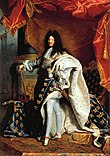
|
Louis XIV "the Great" "the Sun King" |
14 May 1643[xliii] – 1 September 1715 (72年3個月又18天) |
Son of Louis XIII | 5 September 1638 – 1 September 1715 (aged 76) Ruled under the regency of his mother Anne of Austria until 1651. Longest reigning sovereign monarch in history[83] | |

|
Louis XV "the Beloved" |
1 September 1715[xliv] – 10 May 1774 (58年8個月又9天) |
Great-grandson of Louis XIV | 15 February 1710 – 10 May 1774 (aged 64) Ruled under the regency of Philippe II, Duke of Bourbon-Orléans, until 1723[84] | |

|
Louis XVI | 10 May 1774[xlv] – 21 September 1792[u] (18年4個月又11天) |
Grandson of Louis XV | 23 August 1754 – 21 January 1793 (aged 38) Forced to install a constitutional monarchy after 1789. Formally deposed following the proclamation of the First Republic; executed in public[85] |
19世紀(1792年—1870年)
The period known as the "long nineteenth century" was a tumultuous time in French politics, the period is generally considered to have begun with the French Revolution, which deposed and then executed Louis XVI. Royalists continued to recognize his son, the putative king Louis XVII as ruler of France, however Louis was under arrest by the government of the Revolution, and died in captivity having never ruled. The republican government itself went through several changes in form and constitution until France was declared an empire following the ascension of the First Consul Napoleon Bonaparte as Emperor Napoleon I. Napoleon himself would be overthrown twice following military defeats during the Napoleonic Wars. After the Napoleonic period followed two different royal governments, the Bourbon Restoration, which was ruled successively by two younger brothers of Louis XVI, and the July Monarchy, ruled by Louis Philippe I, a distant cousin who claimed descent from Louis XIII. The French Revolution of 1848 brought an end to the monarchy again, instituting a brief Second Republic that lasted only four years before its President declared himself Emperor Napoleon III, who would himself be deposed and replaced by the Third Republic, and ending monarchic rule in France for good.
| Portrait | Name | Arms | Reign | Succession | Life details |
|---|---|---|---|---|---|

|
Louis XVII (claimant) |

|
21 January 1793 – 8 June 1795 (disputed; 2年4個月又18天) |
Son of Louis XVI; named Dauphin on 4 June 1789 | 27 March 1785 – 8 June 1795 (aged 10) Imprisoned by the revolutionary forces on 13 August 1792. Remained in captivity during the entirety of his "reign"[86] |
| Portrait | Name | Arms | Reign | Succession | Life details |
|---|---|---|---|---|---|

|
Napoleon I | 
|
18 May 1804[xlvi] – 6 April 1814 (9年10個月又19天) |
First Consul following the coup d'etat of 19 November 1799; self-proclaimed Emperor of the French | 15 August 1769 – 5 May 1821 (aged 51) Conquered most of Europe in a series of successful wars; remembered as one of the greatest military commanders in history. Forced to abdicate and exiled to the island of Elba[87] |
| Portrait | Name | Arms | Reign | Succession | Life details |
|---|---|---|---|---|---|

|
Napoleon I | 
|
20 March – 22 June 1815 (94 days) |
Restored as Emperor of the French following his escape from the island of Elba. | 15 August 1769 – 5 May 1821 (aged 51) Abdicated in favour of his son following his defeat at the Battle of Waterloo. Exiled to the island of Saint Helena, where he later died of a stomach illness[87] |

|
Napoleon II (claimant) |
22 June – 7 July 1815 (15 days; disputed) |
Son of Napoleon I | 20 March 1811 – 22 July 1832 (aged 21) Remained his entire "reign" hidden in Austria, with his mother Marie Louise. Died of tuberculosis several years later[89] |
| Portrait | Name | Arms | Reign | Succession | Life details |
|---|---|---|---|---|---|

|
Louis XVIII "the Desired" |

|
8 July 1815 – 16 September 1824 (9年2個月又8天) |
Younger brother of Louis XVI; restored to the throne | 17 November 1755 – 16 September 1824 (aged 68) Attempted to rule under a constitutional monarchy. Last French monarch to die while still reigning[88] |
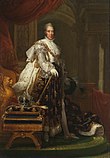
|
Charles X | 16 September 1824[xlviii]– 2 August 1830 (5年10個月又17天) |
Younger brother of Louis XVI and Louis XVIII | 9 October 1757 – 6 November 1836 (aged 79) Leader of the Ultra-royalists; attempted to return to the Ancient Regime. Abdicated in favour of his grandson Henry.[90] | |

|
Louis XIX (claimant) |
2 August 1830 (a few minutes; disputed) |
Son of Charles X | 6 August 1775 – 3 June 1844 (aged 68) Allegedly king for 20 minutes before his own abdication;[v] later legitimist pretender to the throne.[91] | |

|
Henry V (claimant) |
2–9 August 1830 (7 days; disputed) |
Grandson of Charles X | 29 September 1820 – 24 August 1883 (aged 62) Later legitimist pretender to the throne. Died in exile several years later[92] |
The Bourbon Restoration came to an end with the July Revolution of 1830 which deposed Charles X and replaced him with Louis Philippe I, a distant cousin with more liberal politics. Charles X's son Louis signed a document renouncing his own right to the throne only after a 20-minute argument with his father. Because he was never crowned he is disputed as a genuine king of France. Louis's nephew Henry was likewise considered by some to be Henry V but the new regime did not recognise his claim and he never ruled.
| Portrait | Name | Arms | Reign | Succession | Life details |
|---|---|---|---|---|---|
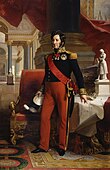
|
Louis Philippe I "the Citizen King" |

|
9 August 1830[xlix]– 24 February 1848 (17年6個月又15天) |
Sixth-generation descendant of Louis XIII, also distant cousin of Charles X | 6 October 1773 – 26 August 1850 (aged 76) Styled as King of the French. Abdicated in favour of his grandson[93] |

|
Louis Philippe II (claimant) |
24–26 February 1848 (2 days; disputed) |
Grandson of Louis-Philippe | 24 August 1838 – 8 September 1894 (aged 56) Later Orléanist pretender to the throne.[94] |
The French Second Republic lasted from 1848 to 1852, when its president, Charles-Louis-Napoléon Bonaparte, was declared Emperor of the French under the regnal name of Napoleon III. He would later be overthrown during the events of the Franco-Prussian War, becoming the last monarch to rule France.
| Portrait | Name | Arms | Reign | Succession | Life details |
|---|---|---|---|---|---|

|
Napoleon III | 
|
2 December 1852[l]– 4 September 1870 (17年9個月又2天) |
Nephew of Napoleon I and former President of France; self-proclaimed Emperor | 20 April 1808 – 9 January 1873 (aged 64) Captured by the German army on 2 September 1870; deposed following the proclamation of the Third Republic.[95] |
王位覬覦者
Various pretenders descended from the preceding monarchs have claimed to be the legitimate monarch of France, rejecting the claims of the president of France and of one another. These groups are:
- Legitimist claimants to the throne of France: descendants of the Bourbons. Unionists recognized the Orléanist claimant after 1883.
- Blancs d'Espagne: descendants of Louis XIV, claiming precedence over the House of Bourbon-Orléans by virtue of primogeniture.
- Orléanist claimants to the throne of France: descendants of Louis-Phillippe, himself descended from a junior line of the Bourbon dynasty, rejecting all heads of state since 1848.
- Bonapartist claimants to the throne of France: descendants of Napoleon I and his brothers, rejecting all heads of state 1815–48 and since 1870.
- English claimants to the throne of France: kings of England and later of Great Britain (renounced by Hanoverian King George III upon union with Ireland in 1800).
- Jacobite claimants to the throne of France: senior heirs-general of Edward III of England and thus his claim to the French throne, also claiming England, Scotland, and Ireland.
年表

另見
- Family tree of French monarchs
- Family tree of French monarchs (simplified)
- Style of the French sovereign
- English claims to the French throne
- List of French royal consorts
- List of heirs to the French throne
- List of presidents of France
註解
參考文獻
Wikiwand in your browser!
Seamless Wikipedia browsing. On steroids.
Every time you click a link to Wikipedia, Wiktionary or Wikiquote in your browser's search results, it will show the modern Wikiwand interface.
Wikiwand extension is a five stars, simple, with minimum permission required to keep your browsing private, safe and transparent.










